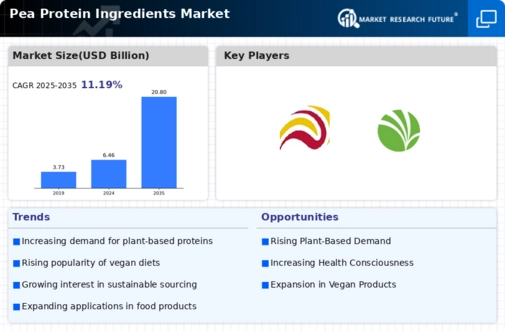Pea Protein Ingredient Size
Pea Protein Ingredient Market Growth Projections and Opportunities
The pea protein ingredients market is shaped by a confluence of factors that collectively define its growth trajectory and market dynamics. One primary driver is the increasing demand for plant-based protein sources, fueled by a rising awareness of health and sustainability. As consumers seek alternatives to traditional animal-based proteins, pea protein has gained prominence for its nutritional profile and environmentally friendly attributes. Pea protein is recognized for being rich in essential amino acids, allergen-friendly, and boasting a low environmental footprint compared to some animal-based protein sources, aligning with the preferences of an expanding segment of health-conscious and environmentally aware consumers. The broader trend of plant-based diets and the growing popularity of vegetarian and vegan lifestyles significantly contribute to the growth of the pea protein ingredients market. Pea protein serves as a versatile and effective plant-based protein alternative in a variety of food and beverage applications, ranging from plant-based meat substitutes to dairy alternatives and protein-enriched snacks. This versatility positions pea protein as a key player in the evolving landscape of plant-centric diets, appealing to consumers looking for sustainable and cruelty-free protein sources. Health consciousness and the pursuit of clean-label products are additional factors influencing the pea protein market. With an increasing emphasis on natural and minimally processed ingredients, pea protein aligns with consumer preferences for clean labels, free from artificial additives and preservatives. The clean-label trend extends beyond health considerations to include transparency in sourcing and production practices, further shaping the market as consumers prioritize products with a clear and ethical supply chain. Environmental sustainability is a pivotal factor shaping the pea protein ingredients market. Peas are nitrogen-fixing crops that improve soil health, and their cultivation typically requires fewer resources compared to some other protein crops. The eco-friendly footprint of pea protein resonates with consumers seeking sustainable and environmentally responsible choices. As concerns about climate change and resource depletion grow, the market responds to the demand for plant-based proteins with a lower environmental impact, positioning pea protein as a favorable option. Government regulations and policies also play a role in influencing the pea protein market. Supportive policies that encourage sustainable agriculture and the development of plant-based protein sources can positively impact the industry. Additionally, labeling regulations and health claims related to pea protein contribute to shaping consumer perceptions and market dynamics. Global economic conditions and trade relationships further contribute to the market factors of pea protein ingredients. Economic stability and growth in emerging markets can increase disposable income, influencing consumer spending habits and the demand for premium plant-based products. Conversely, economic downturns may impact consumer preferences and purchasing decisions, influencing the market landscape. Technological advancements in processing methods and ingredient innovation play a crucial role in shaping the pea protein market. Ongoing research and development efforts contribute to improving the taste, texture, and functionality of pea protein, expanding its applications in various food and beverage products. These advancements contribute to the market's competitiveness and its ability to meet the evolving demands of both manufacturers and consumers.







Leave a Comment